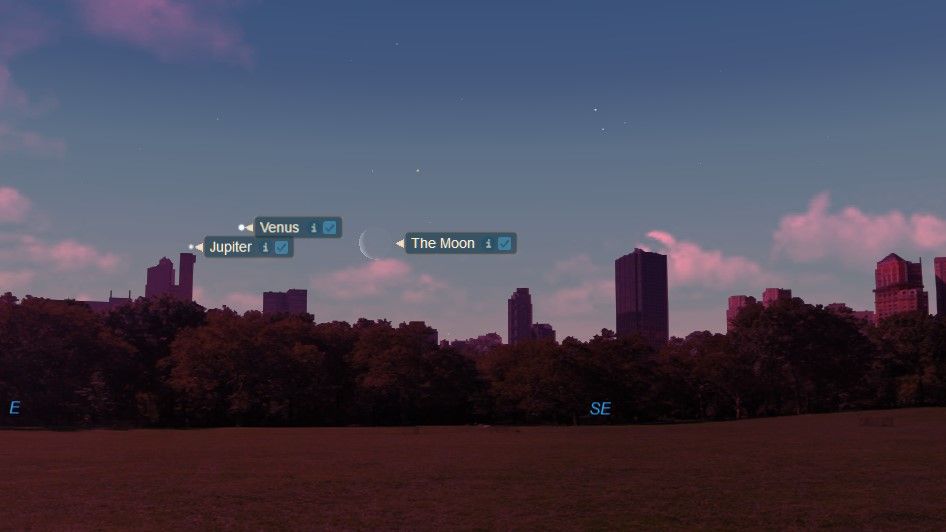
Venus and Jupiter align this week in spectacular morning sky shows (Image Credit: Space.com)

The celestial highlight in the days ahead will involve the three brightest objects in the nighttime sky: the moon and the planets Venus and Jupiter.
On Tuesday morning (April 26), you’ll want to be sure to set your alarm. About 45 minutes before sunrise, look low toward the east-southeast horizon. Here, you’ll see Venus hovering 4 degrees to the upper right of Jupiter; about a dozen degrees away to the planets’ right will be a waning crescent moon, seemingly admiring from a far those two brilliant worlds.
Come the very next morning (April 27) at about the same time, a slightly thinner lunar crescent will have moved in to join the two planets, forming an eye-catching triangle formation. The moon-Jupiter side will measure 4 degrees, while the moon-Venus side will measure 5 degrees; Venus and Jupiter will have closed the gap between them to just 3 degrees.
Related: Partial solar eclipse of April 2022: When and where it is and how to watch it online

Of course, what we’ll be seeing both mornings is an illusion of perspective. The two planets are nowhere near each other; they just happen to line up with each other from our Earthly vantage point. Venus will be 90.3 million miles (145.4 million kilometers) from us, while Jupiter is nearly six times farther away at 530 million miles (852.8 million km). Meanwhile, the moon is by far the closest at just 239,000 miles (384,000 km) away.
Weather permitting, for those with no tall obstructions (such as trees or buildings) toward the east-southeast, this triangular trio should make for a very striking visual spectacle, no doubt attracting the attention of even those who don’t give more than a casual glance to the sky. I suspect the combination of the objects’ great brightness, their closeness to one another and their low altitude will induce more than a few people to call local media outlets and maybe even police stations to report a UFO sighting.
Snuggle time!
Finally, on Saturday morning (April 30), Venus and Jupiter will appear to snuggle close together, separated by just one-half degree, or equal to the apparent width of the moon. The two planets will rise side-by-side that morning, with Jupiter on the left, Venus on the right. Venus will be markedly brighter at magnitude -4.1; Jupiter will shine at magnitude -2.1 and will be about one sixth as bright as Venus.

Binoculars and telescopes can provide some magnificent views of Venus and Jupiter for several days around April 30. Venus will appear slightly gibbous, while Jupiter will display a large disk crossed by cloud bands and accompanied by the four Galilean satellites, which change their respective positions to each other hour by hour and night to night.
Venus and Jupiter will still be very close to each other on Sunday (May 1), when Jupiter will be to the upper right of Venus; in the mornings that follow, the giant world will steadily pull away to the west.
Migrating worlds
This week’s celestial displays mark a stark change from the beginning of April, when only one of these two planets was even on stage. That was Venus, which has been a dazzling morning object since mid-January.
Jupiter had disappeared into the sunset fires during the latter part of February and passed through conjunction with the sun on March 5. Since then, it has been a morning object, but was still too close to the sun’s glare to be seen at the start of this month.
This largest of planets only became visible around April 8, when Jupiter finally began appearing about a half hour before sunrise, very low to the eastern horizon and 20 degrees — the equivalent of the width of two fists held at arm’s length — to the lower right of Venus.
Since then, Jupiter has been slowly ascending — getting higher and more prominent; Venus will continue to rise more or less at dawn’s first light right on through the middle of August. In essence they are like two ships passing each other in the morning twilight.
Joe Rao serves as an instructor and guest lecturer at New York’s Hayden Planetarium. He writes about astronomy for Natural History magazine, the Farmers’ Almanac and other publications. Follow us on Twitter @Spacedotcom and on Facebook.





